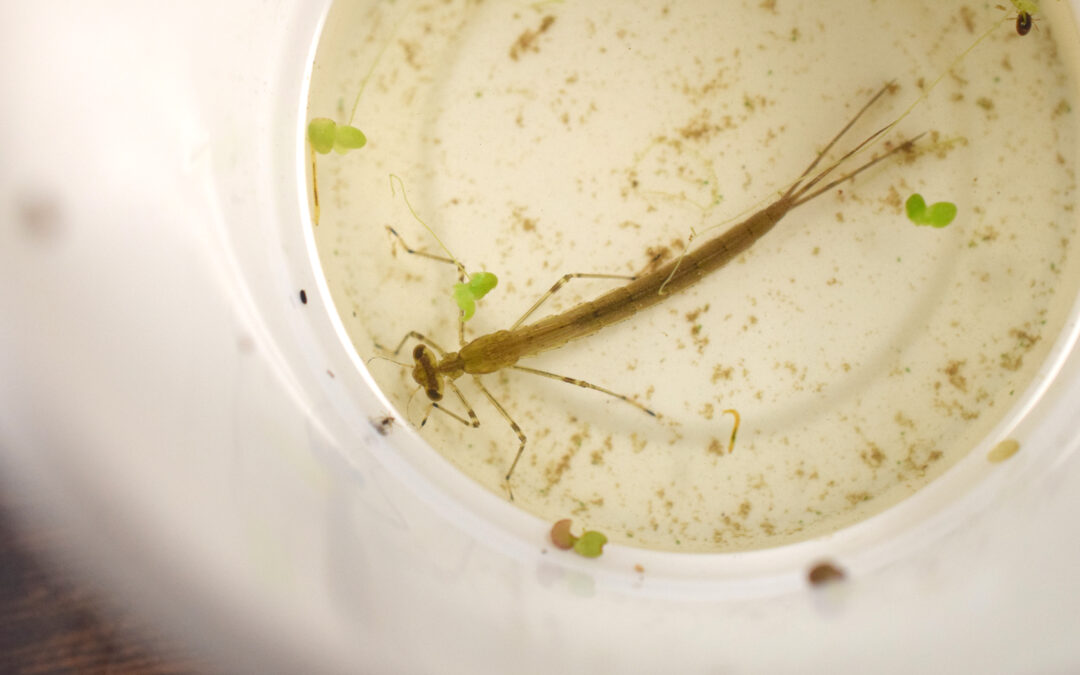By: Charlotte Schmaltz, Nature Educator
On a warm spring day, if I gaze out into the backyard pond at Audubon my first impression is of calm, clear water. Though the water may seem empty at first, the longer I look, the more I notice. First might be a bit of plant matter floating on the surface or a hint of debris stirred up from the bottom of the pond. However, a closer look reveals an entire world living in the shallows. Soon after, it becomes easy to spot the movement of tiny creatures, at home in the water. Many of those small organisms visible in the water are known as aquatic macroinvertebrates. Invertebrates are those creatures without backbones, and the “macro” part of the word means that you can see these aquatic individuals without the use of microscope.

Macroinvertebrates living in the water are often larval forms of insects you might see on later on land, like dragonflies and damselflies, but some adults will remain aquatic for their entire lives. Occasionally an adult can even be seen carrying a collection of tiny eggs on their back. Between these life stages and the diversity of species, the type and number of body parts can differ wildly. These differences are particularly striking when watching them move around.
While some macroinvertebrates swim as expected, using their legs to propel them forwards, there are other ways of getting around. The worm-like ones may move in an S-shape, but some squirm wildly back and forth in a dizzying dance. Not all legs are suitable for swimming, and others will simply walk along the bottom. Many beetles call the water home, and a few species have adapted to swim upside down. Sometimes their speed is enough that you can lose sight of one between blinks, but others, like snails, move so slowly that it can be hard to notice movement at all. Then there are the macroinvertebrates that don’t live under the water, but on top of it, skating over the surface like its solid ground.
Personally, I love observing macroinvertebrates. Their unique appearances and ways of moving are fascinating to watch. It’s amazing how, just by pausing to take a closer look, a whole new world can reveal itself.

As we approach summer and the temperature continues to increase, the population of macroinvertebrates will too. As time moves forward, some of them may leave the water to emerge as their adult forms, spending the rest of their lives on land or in the air.
The presence of macroinvertebrates is a great indicator of water quality. At Audubon it is easy to find a dozen species or more hidden in the shallows near the shore, many of which are sensitive to pollutants in the water. Finding so many is a sign that the water, and therefore the environment, is in good health. In addition, many vertebrates use macroinvertebrates as a source of food. Although they may be nearly invisible at first glance, macroinvertebrates are a critical part of their ecosystem.
Audubon Community Nature Center builds and nurtures connections between people and nature. ACNC is located just east of Route 62 between Warren and Jamestown. The trails are open from dawn to dusk and birds of prey can be viewed anytime the trails are open. The Nature Center is open from 10 a.m. until 4:30 p.m. daily except Sunday when it opens at 1 p.m. More information can be found online at auduboncnc.org or by calling (716) 569-2345.


Recent Comments